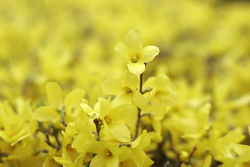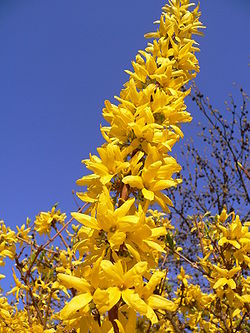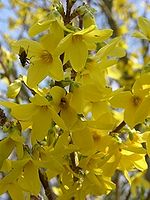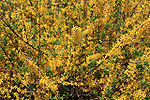Forsythia
| Forsythia |
|---|

|
| Scientific Classification |
|
| Species |
|
| Forsythia Suspensa |
Forsythia is a yellow and shiny flower that commonly lives in East Asia, which is commonly known as a "golden bell". Forsythia is a taxonomic genus of angiosperms that are mostly Forsythia is used for gardening. They are usually propagated by cutting and rooting for commercial purposes.[1]
Anatomy
Forsythias are yellow flower plants with long thin branches. Their height typically ranges from 1-3 meters, but some of them grows up to six meters. They have grey-brown bark. The leaves are usually arranged opposite, but sometimes three leaves grow around the same spot. The edge of the leaves is either toothed or smooth. Leaves are about 2-10 cm long. [2] In the spring, the color the leaves is dark green, but in autumn, when they are ready to fall off, they are yellow-green color.[3]
Bright yellow flowers of Forsythias bloom before the leaves. A flower has four petals, and the petals are connected to the bottom of the flower. In rainy seasons, petals cover the inside of the flower, protecting its reproductive organs from getting wet.[4] Flowers are about 3-4 cm long, and they are clustered in groups of two to six.[5]
Reproduction
Forsythias are angiosperms, meaning that they reproduce with their flowers [6]. Most of fruit are process after the process of sexual reproduction, small capsules of fruits are formed. These fruits are planted to give a rise to more Forsythias.
For commercial purposes, Forsythias are usually reproduced by cutting or rooting, an asexual reproduction of plants. Usually one to two year old plants are used. Forsythia branch is cut, and planted on the soil, which becomes an independent plant. Sometimes, the branch is directly planted without cutting, and when roots form, the branch is cut to form a new plant.[7]
Ecology
Forsythias are usually seen in East Asian countries. In different countries, different species of Forsythias are observed. For example, in China, F. mandschurica and F. likiangensis are majorly seen, and in Korea, F. koreana is prevalent.[8] Flowers blooms in March and April, and they last for two to three weeks. Leaves appear after flowers, and they last until late fall. [9] Forsythias grows very well under full sunshine, that they will have full bloom under it. [10]
Some species of moth and butterflies lay their eggs on Forsythias, and the larvae of these insects feed off of leaves of Forsythias [11]
Medical, Herbs & Uses
Forsythia has shiny and yellow flowers which makes it a very nice plant for gardening purposes. They are very commonly used in gardens and parks all over the world. [12]
Forsythia is also known as an incredible medical source. In Chinese herbology, Forsythia is regarded as one of the 50 fundamental herbs. Even though there is little evidence supporting the effectiveness of Forsythia, this plant is used for treating bacterial infections and respiratory diseases in east Asian countries.[13] Also in Korea, Forsythia is used to make traditional string instrument called Ajaeng.[14]
Gallery
References
- Forsythia Drug fact by Wolters Kluwer, Micromedex™, Apr 25th, 2011.
- Forsythia Unknown, Forsythia Wikipedia, Accessed Apr 24th 2011.
- Gardening Forsythia Unknown, Doug's Green Beginning Gardening, Accessed Apr 24th 2011.
- Border Forsythia Unknown, Hort.uconn, Accessed May 3rd 2011.
- Flowering plant Wikipedia Unknown, Flowering plant Wikipedia, Accessed May 3rd 2011.
- The Garden Helper Unknown, The Garden Helper, Accessed Apr 28th 2011.






